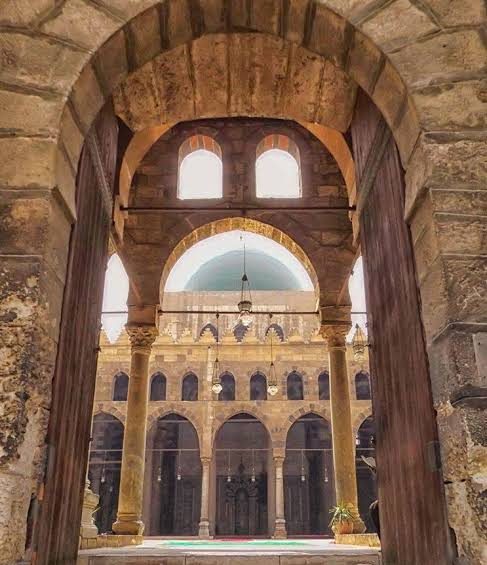Citadel of Cairo (Part II)
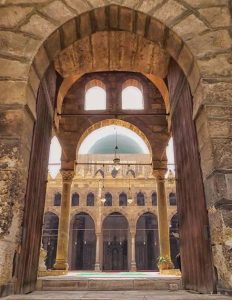
The Mosque of Al-Nasir Muhammad
It was built by one of the greatest sultans of the Mamluk era, Sultan Al-Nasir Muhammad ibn Qalawun, who sat on the throne of the builder sultans. He presented to Egypt, and indeed to the Islamic world, many examples that witnessed the beauty of Islamic architecture, especially in the Mamluk era. For in his era, more than 94 structures were built, specifically by him and his princes. He is the greatest sultan in the history of Islamic architecture in Egypt. He built the mosque to be the official mosque of the citadel in 718 AH, 1318 AD. He added other service buildings to its area, and the mosque could accommodate more than five thousand worshipers. The mosque remained the official mosque of the citadel until the arrival of Muhammad Ali Pasha and the construction of his famous mosque in the citadel. To facilitate its role, Al-Nasir Muhammad appointed 12 muezzins and imams for it. Therefore, the Mosque of Al-Nasir Muhammad is considered one of his best architectural works.
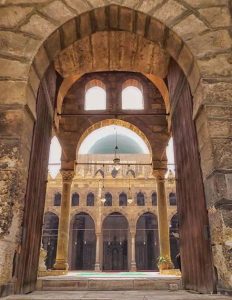 The mosque is considered one of the large mosques and follows the traditional plan, as it consists of an open middle courtyard surrounded by four Arcades. It contains many windows and arcades supported by columns with different capitals. Some of them are Corinthian capitals and Coptic capitals, and we find the existence of cross shapes on some of the capitals of the mosque’s columns. The mosque is distinguished by its dome being covered with green ceramics, and so are the minarets, as the mosque includes two minarets for the call to prayer for the civil and military sections of the citadel. The qibla wall contains three mihrabs that were covered with colored marble and decorated with geometric decorations of fine marble mosaics inlaid with shells. We find a wooden minbar of recent construction made by the Arab Antiquities Preservation Committee in 1949 during the reign of King Farouk. The mosque is also distinguished by its memorial entrance, which is decorated with the ablaq system and adorned with different inscriptions. Perhaps the most distinctive feature of the Mosque of Al-Nasir Muhammad is the presence of a sundial on one of the columns of the western arcade, which was used to determine prayer times. It was made by Ahmad ibn Baktamur al-Saqi and is one of the oldest remaining examples in Islamic Egypt.
The mosque is considered one of the large mosques and follows the traditional plan, as it consists of an open middle courtyard surrounded by four Arcades. It contains many windows and arcades supported by columns with different capitals. Some of them are Corinthian capitals and Coptic capitals, and we find the existence of cross shapes on some of the capitals of the mosque’s columns. The mosque is distinguished by its dome being covered with green ceramics, and so are the minarets, as the mosque includes two minarets for the call to prayer for the civil and military sections of the citadel. The qibla wall contains three mihrabs that were covered with colored marble and decorated with geometric decorations of fine marble mosaics inlaid with shells. We find a wooden minbar of recent construction made by the Arab Antiquities Preservation Committee in 1949 during the reign of King Farouk. The mosque is also distinguished by its memorial entrance, which is decorated with the ablaq system and adorned with different inscriptions. Perhaps the most distinctive feature of the Mosque of Al-Nasir Muhammad is the presence of a sundial on one of the columns of the western arcade, which was used to determine prayer times. It was made by Ahmad ibn Baktamur al-Saqi and is one of the oldest remaining examples in Islamic Egypt.
 The mosque has suffered greatly since the Mamluk era. It was affected by many fires that hit the Citadel of Salah al-Din al-Ayyubi, along with many explosions that affected its columns and led to the collapse of some of them. The misuse and deliberate insult by British occupation soldiers during their presence in the Citadel of Salah al-Din was a stark and severe example of misuse and insult, as it was used as warehouses for grain for horses and a pasture for some animals used at that time. The Arab Antiquities Preservation Committee restored the pulse to the body of the Mosque of Al-Nasir Muhammad, as it carried out its renovation and restoration and returned it to its previous state. The mosque is now a prominent and distinctive landmark in the history of the Citadel of Salah al-Din and one of the most famous and greatest tourist attractions inside it
The mosque has suffered greatly since the Mamluk era. It was affected by many fires that hit the Citadel of Salah al-Din al-Ayyubi, along with many explosions that affected its columns and led to the collapse of some of them. The misuse and deliberate insult by British occupation soldiers during their presence in the Citadel of Salah al-Din was a stark and severe example of misuse and insult, as it was used as warehouses for grain for horses and a pasture for some animals used at that time. The Arab Antiquities Preservation Committee restored the pulse to the body of the Mosque of Al-Nasir Muhammad, as it carried out its renovation and restoration and returned it to its previous state. The mosque is now a prominent and distinctive landmark in the history of the Citadel of Salah al-Din and one of the most famous and greatest tourist attractions inside it
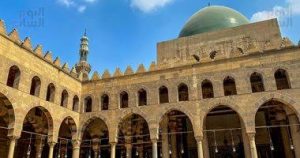
Jewel Palace
It is one of the most famous and beautiful palaces in the Citadel of Salah al-Din al-Ayyubi. It was originally built to be a residence for the wife of Muhammad Ali Pasha and was built in 1814. Muhammad Ali was keen that this palace be extremely luxurious and magnificent. It includes many different halls, the most famous of which is the reception hall and the clock hall, which are among the most beautiful things to see inside the palace. The palace was decorated with the finest Ottoman decorative arts, whether in wood or gypsum panels. For a period of time, the palace was converted into a heritage museum. The palace was for long periods a venue for official receptions until the era of Khedive Ismail. Among the most famous of these visits was his reception of Sultan Abdul Aziz Khan in 1279 AH, 1862 AD, where he stayed for more than seven days. Many other heads of state were also received at the Jewel Palace throughout its history.
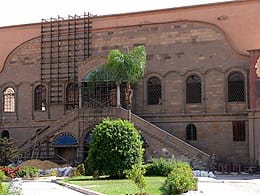 one of the most famous historical events associated with the Jewel Palace is its close connection to one of its most dramatic events, the massacre of the Mamluks. The senior princes of the Mamluks were received in the reception hall before the implementation of the carefully planned scheme by Muhammad Ali Pasha to assassinate them all while they were celebrating the farewell of his son for his departure to suppress the Wahhabi movement in the Hijaz. The palace also houses the most famous gifts that were presented to the family of Muhammad Ali until the era of King Farouk. It also houses collections, but unfortunately, the palace has been subjected to several fires and explosions, which caused a lot of damage to it, leading to its restoration many times.
one of the most famous historical events associated with the Jewel Palace is its close connection to one of its most dramatic events, the massacre of the Mamluks. The senior princes of the Mamluks were received in the reception hall before the implementation of the carefully planned scheme by Muhammad Ali Pasha to assassinate them all while they were celebrating the farewell of his son for his departure to suppress the Wahhabi movement in the Hijaz. The palace also houses the most famous gifts that were presented to the family of Muhammad Ali until the era of King Farouk. It also houses collections, but unfortunately, the palace has been subjected to several fires and explosions, which caused a lot of damage to it, leading to its restoration many times.
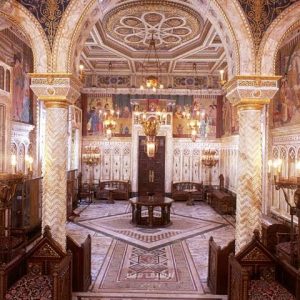 The architectural plan of the Jewel Palace consists of several main blocks consisting of two floors, starting with the main entrance in front of which is a canopy supported by marble columns. To the left of this entrance is a building characterized by simplicity and decoration and is connected to the Palace of Justice, which was built by Muhammad Ali Pasha. At the end of the entrance, there is a rectangular room with a double staircase that was reserved for palace employees. The second floor also included a reception wing. Rococo and Baroque decorations were used on the interior walls of the palace. The gilded engravings are based on plant shapes, vases, and curtain drawings characterized by repetitive decorative units. There are also other halls made of alabaster or marble. The Jewel Palace is one of the most famous and greatest palaces in the Citadel of Salah al-Din al-Ayyubi.
The architectural plan of the Jewel Palace consists of several main blocks consisting of two floors, starting with the main entrance in front of which is a canopy supported by marble columns. To the left of this entrance is a building characterized by simplicity and decoration and is connected to the Palace of Justice, which was built by Muhammad Ali Pasha. At the end of the entrance, there is a rectangular room with a double staircase that was reserved for palace employees. The second floor also included a reception wing. Rococo and Baroque decorations were used on the interior walls of the palace. The gilded engravings are based on plant shapes, vases, and curtain drawings characterized by repetitive decorative units. There are also other halls made of alabaster or marble. The Jewel Palace is one of the most famous and greatest palaces in the Citadel of Salah al-Din al-Ayyubi.
Mosque of Sarija al-Jabal
It was built by Suleiman Pasha al-Khadim, one of the Ottoman governors of Egypt in 1529. He is considered one of the prominent statesmen of the Ottoman Empire during the reign of Sultan Suleiman the Magnificent. The mosque is the first mosque built under Ottoman rule in Egypt. It was built on the ruins of an old Fatimid Mosque belonging to Abu Mansur Qusta, the governor of Alexandria. The mosque was built to be for Ottoman soldiers, especially after the collapse of the Mosque of Al-Nasir Muhammad ibn Qalawun as a result of successive fires.
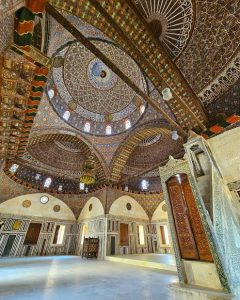 The mosque consists of two sections. The first section is covered by a dome in the middle surrounded by half-domes decorated with colorful inscriptions interspersed with writings, and the walls are covered with marble pieces. The second section is an open middle courtyard surrounded by four arcades covered with domes. The mosque is distinguished by the presence of a beautifully crafted marble minbar with inscriptions on its sides on a plant-based background of Arabesque decorations. The ceilings were also decorated with plant decorations such as leaves and geometric shapes, adding a blend of art and psychological comfort to the place. Therefore, the Mosque of Sariya al-Jabal is considered one of the most beautiful mosques built during the Ottoman rule in Egypt.
The mosque consists of two sections. The first section is covered by a dome in the middle surrounded by half-domes decorated with colorful inscriptions interspersed with writings, and the walls are covered with marble pieces. The second section is an open middle courtyard surrounded by four arcades covered with domes. The mosque is distinguished by the presence of a beautifully crafted marble minbar with inscriptions on its sides on a plant-based background of Arabesque decorations. The ceilings were also decorated with plant decorations such as leaves and geometric shapes, adding a blend of art and psychological comfort to the place. Therefore, the Mosque of Sariya al-Jabal is considered one of the most beautiful mosques built during the Ottoman rule in Egypt.

The coinage house and the Palace of Justice
Ibrahim Pasha al-Kobtan established the current coinage house in the Citadel of Salah al-Din al-Ayyubi in 1710. Later, Muhammad Ali Pasha renovated and renewed it. It represented the central bank of Egypt at that time, as it produced the official currency of the Egyptian state, including gold dinars and silver dirhams. It had a supervisory authority for minting coins and its tools. It included many places for smelting, forging, and hammering, as well as a special workshop for thinning and another for cutting and polishing. It consists of a rectangular area with an open courtyard to which many rooms were attached. There are domes above them with openings for the escape of flames and smoke during the smelting process. There are also skylights for lighting and ventilation during the process of manufacturing the currency at that time
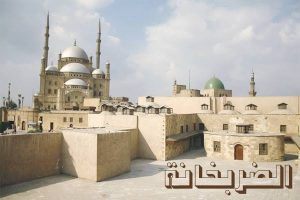 More than 500 workers worked in the coinage house. In fact, the number of workers during the French campaign exceeded 300 workers, including their wives and children. This coinage house reached the top of its prominence during the reign of Muhammad Ali Pasha, even surpassing the Istanbul mint thanks to the modern tools and machines that were imported, which produced high-quality currency for which the Egyptian state was famous at that time. Over time, the coinage house was subjected to a lot of neglect and abandonment, leading to more than one restoration and maintenance operation. Perhaps the state will soon reuse this building as a special museum for Egyptian coins.
More than 500 workers worked in the coinage house. In fact, the number of workers during the French campaign exceeded 300 workers, including their wives and children. This coinage house reached the top of its prominence during the reign of Muhammad Ali Pasha, even surpassing the Istanbul mint thanks to the modern tools and machines that were imported, which produced high-quality currency for which the Egyptian state was famous at that time. Over time, the coinage house was subjected to a lot of neglect and abandonment, leading to more than one restoration and maintenance operation. Perhaps the state will soon reuse this building as a special museum for Egyptian coins.
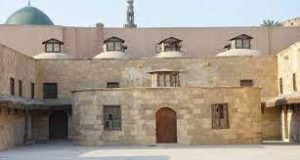 Many different diwans (governmental offices) and ministries were built within the Citadel of Salah al-Din al-Ayyubi throughout its history. Perhaps the most famous of these diwans is the Palace of Justice, which was established in the Mamluk era and was renovated and rebuilt again during the reign of Muhammad Ali Pasha. We find the Palace of Determination, and next to it, the seat of Sultan Qaitbay, who built many buildings within the Citadel of Salah al-Din al-Ayyubi, most of which unfortunately have disappeared as a result of neglect, fires, and explosions that have occurred in the Citadel of Salah al-Din al-Ayyubi throughout its history.
Many different diwans (governmental offices) and ministries were built within the Citadel of Salah al-Din al-Ayyubi throughout its history. Perhaps the most famous of these diwans is the Palace of Justice, which was established in the Mamluk era and was renovated and rebuilt again during the reign of Muhammad Ali Pasha. We find the Palace of Determination, and next to it, the seat of Sultan Qaitbay, who built many buildings within the Citadel of Salah al-Din al-Ayyubi, most of which unfortunately have disappeared as a result of neglect, fires, and explosions that have occurred in the Citadel of Salah al-Din al-Ayyubi throughout its history.

